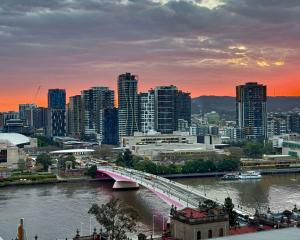
Jinigudera Country
Why it's special
Around Ningaloo Reef, the world’s largest fringing coral reef, a miracle birth occurs every year. One week after the full moon in March or April, coral along the 260km-long reef begins to spawn, filling the sea with millions of eggs and oodles of sperm. It’s a phenomenon that attracts swarms of feasting krill and plankton and, in hungry pursuit of those tiny creatures, the world’s largest fish — the whale shark.

Swimming beside these gentle giants is one of the big-ticket items in West Australian travel. During the whale shark season, boats head out daily through the World Heritage-listed reef in search of what they locally call "our spotted fish".
The world is transformed when you slip into the ocean and begin swimming beside these slow-moving sharks that are larger than great whites.
It is, without question, one of the most thrilling and humbling wildlife encounters in the country.
These harmless sharks of mystery — where they go after they leave Ningaloo each year is unknown, and they’ve never been observed giving birth — are the stars of the show, but they could also be a ticket to a world of other whales and sharks. Reef sharks are commonly sighted inside the reef among the coral "bommies" (outcrops of coral) and from July to August the whale shark season intersects with the humpback whale migration along the West Australian coast, bringing the very real possibility of whale sightings.
The adventure
The tourist town of Exmouth has a special verb: "whale sharking". To go whale sharking is to head out into the Indian Ocean, slip off the back of a boat and swim beside the largest fish on the planet.
One of Ningaloo Reef’s most appealing qualities is its proximity to shore. In places, the reef runs just a few hundred metres from the coast, visible from the shores as a white line of breaking surf. Inside the reef, the lagoon is furnished with a plethora of coral bommies and whale shark boats typically make a first stop among these for a trial snorkel. These few minutes in the water give you the chance to fit and test snorkels, mask and fins, while drifting over bommies and among the marine life that gathers around them — fish as colourful as paint charts, and the menacing shapes (but not menacing natures) of black- and white-tip reef sharks.

Spotter planes are used to locate whale sharks swimming at the surface of the ocean. Often, it’s just minutes before the skipper gets word: whale sharks ahoy.
Entering the water is akin to a military manoeuvre. As the boat stops near the whale shark, you sit at the stern, fins and mask fitted, ready to plunge. A call of "go, go, go" comes from a deckhand and you slide into the ocean, waiting on the surface as the exact position of the shark is ascertained. When you do then pop your face into the water, the giant fish will likely be swimming past just metres away.
The whale sharks around Ningaloo Reef are typically mere teenagers. These herculean fish grow up to 12m in length (although the largest recorded was 18.8m), while those at Ningaloo are more commonly about 3m to 8m.

For a few minutes you swim beside this fantastic fish. Whale sharks typically move slowly, so it is fairly easy to keep pace as their tails flick languidly, their gills ripple, their postbox-like mouths open to draw in water and plankton and an entourage of small fish hitchhike along too. The sharks swim so near the surface you can often raise your head above water and see their enormous shadow on the water. Equally surreal is the North West Cape coastline so close by.
Regulations (as well as common sense and respect) decree that you remain at least 3m from the shark, although as with all wildlife encounters, the animals do not always abide by rules — whale sharks have been known to be drawn to the bubbles made by swimmers’ fins, mistaking them for plankton, creating an adrenaline-pumping moment of dodge the fish.

There is another grand creature in Ningaloo’s almanac of marine experiences. Manta rays are also drawn to the reef by the spawning of the coral, creating another swimming experience for visitors. Coral Bay, at the southern end of the reef, is the main centre for swims with these graceful, highly intelligent fish that are the world’s largest rays, with wingspans of up to 4m. Boat trips to swim with mantas operate year-round out of Coral Bay.
The details
Where: Trips depart from Exmouth, 1250km north of Perth/Boorloo. There are direct flights to Exmouth from Perth/Boorloo and Melbourne/Naarm.

Do it: Exmouth Dive & Whalesharks runs daily whale shark trips from March through September. Book online: (exmouthdiving.com.au).
Fitness: 2 out of 5
Fear factor: 2 out of 5
Expertise required: 1 out of 5
Family friendly
The book
This is an edited extract from Ultimate Adventures: Australia by Andrew Bain, published by Hardie Grant Explore. Available in shops from November 29. RRP $NZ50.












